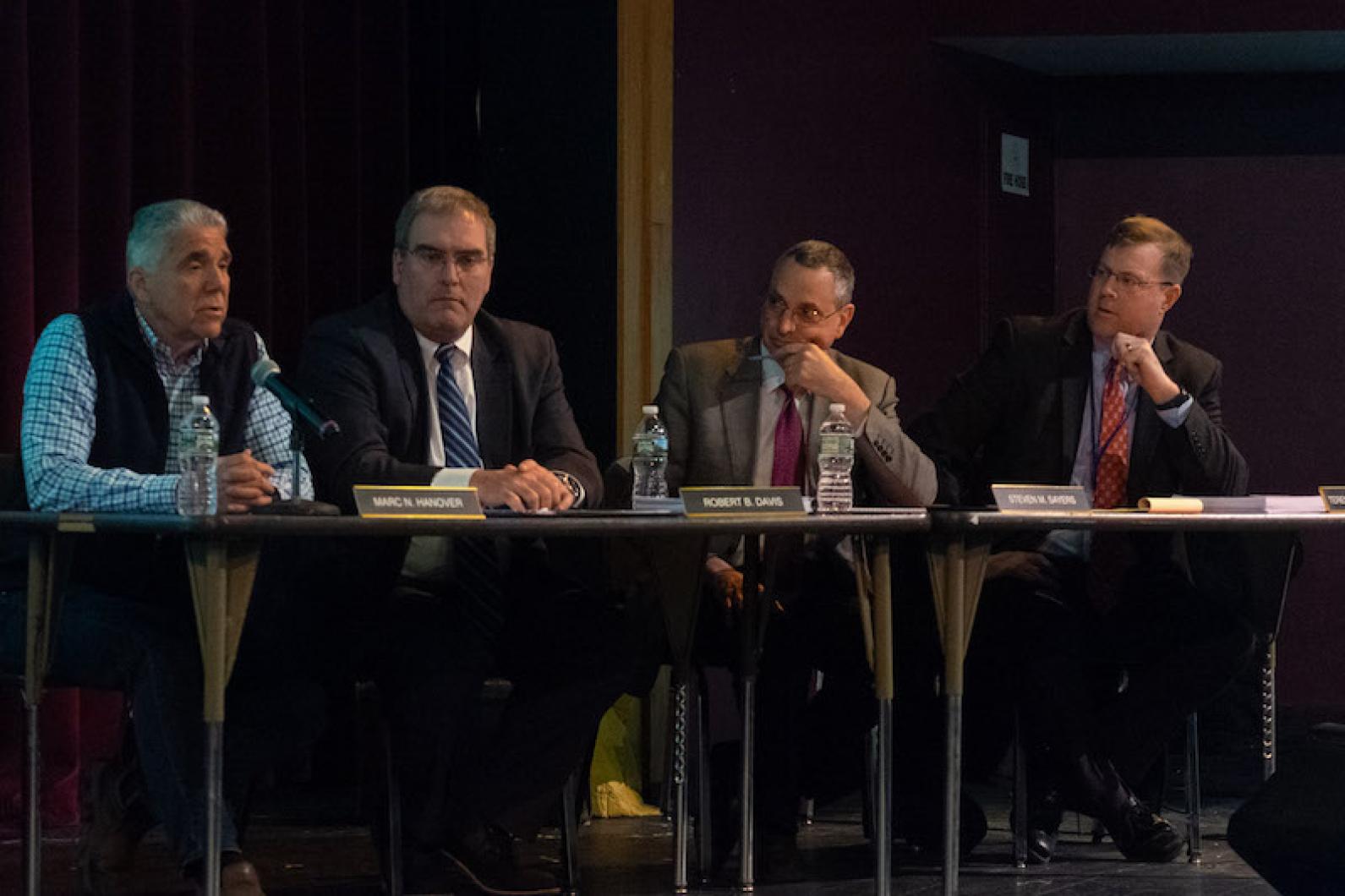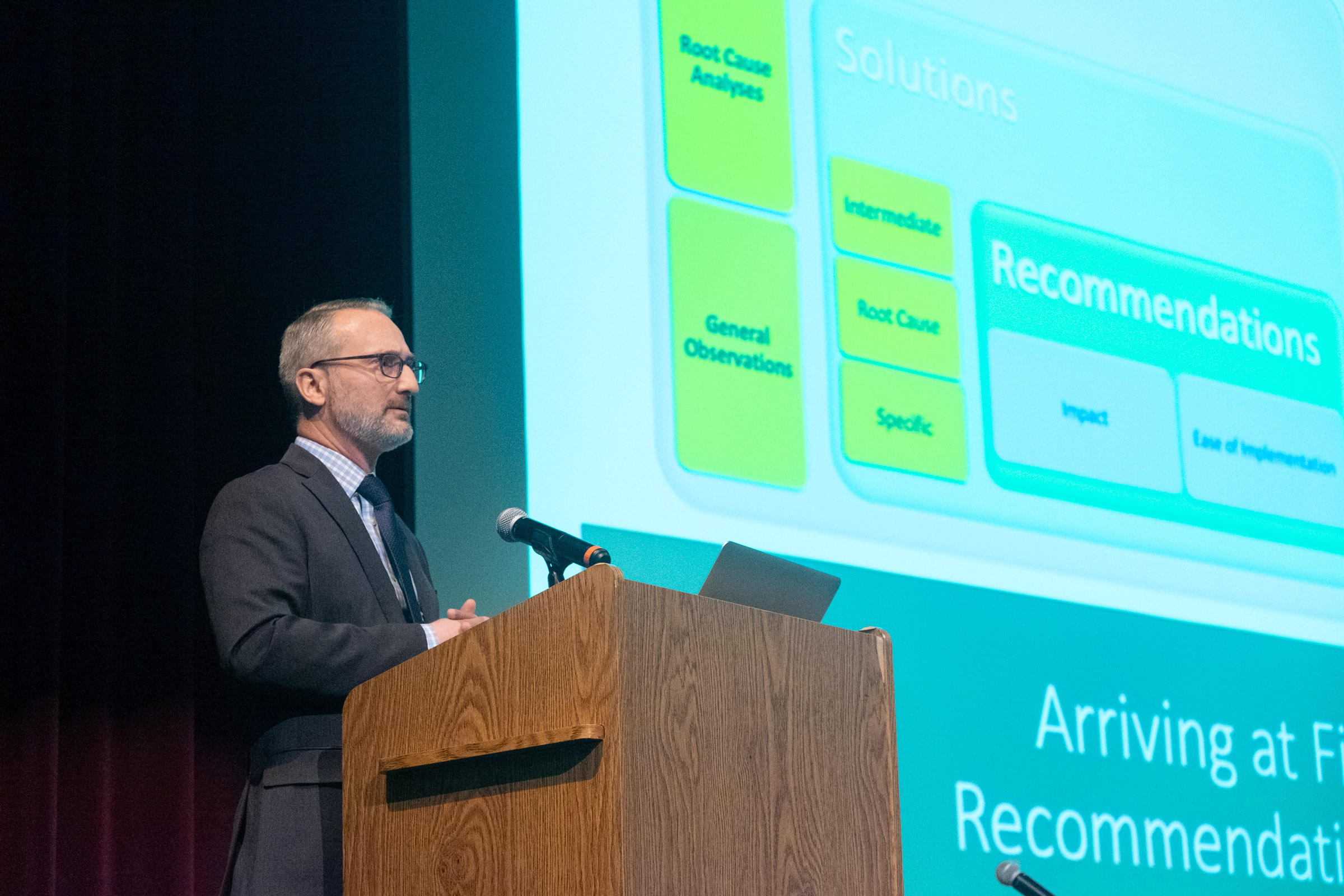The Steamship Authority is taking steps to create and fill new management positions and add computerized systems for training, safety and quality, senior managers and their independent consultants told a sparse gathering of Islanders at the Martha’s Vineyard Performing Arts Center Tuesday night.
Aimed at preventing another series of ferry breakdowns and system failures like the ones that crippled the boat line a year ago, the changes are expected to cost $1 million to adopt and another $1 million annually in the operating budget.
“That’s a significant amount. I understand that,” said John Sainsbury, president of HMS Consulting in Seattle, who led the recent comprehensive review of boat line operations.
Unlike the night before, when more than 100 Islanders crowded a meeting with state legislators and many aired ongoing concerns about the SSA, the meeting hosted by the boat line Tuesday saw scant attendance.
About 35 people were scattered in seats around the cavernous performance center as Mr. Sainsbury delivered his hour-long presentation in tandem with Matthew Lankowski, an ocean engineer on the consulting team.
Only 10 or so audience members made it to the end of the second hour, which was largely given to questions from Islanders and answers from the consultants and SSA top management.
The presentation took listeners over familiar ground, as Mr. Sainsbury and Mr. Lankowski walked the audience through the $218,000 report that was released in December and has been widely distributed and discussed.
The report covered five key areas of boat line operations — vessel operations, fleet maintenance, information technology, management structure and public communications — and made 10 overall recommendations for improvement.
Last month SSA governors voted to retain HMS at a cost of $135,000 to help put the recommendations into practice.
Changing the management structure is a key recommendation, including adding a chief operating officer as a second in command under general manager Robert Davis.
Mr. Davis, who had originally expressed doubt about the need for a COO, said Tuesday that a discussion of the proposed new position will be part of the next SSA board meeting in Falmouth on March 19.
Retired general counsel Steven Sayers, who is working part time for the SSA, said there has been progress since the report came out.
The boat line has “embraced [the report’s recommendations], both substantively and in spirit,” Mr. Sayers said.
“We had some questions about some of them, whether they could be refined, and we’re having those discussions on an ongoing basis with [HMS],” he continued from a seat on the stage alongside Mr. Davis and general counsel Terence G. Kenneally.
The current contract with HMS should take about a year, with quarterly reports “so that they keep a hold on us, to make certain that we have the resolve and that we continue with the resolve to implement the recommendations,” Mr. Sayers said.
The boat line has begun recruiting for a new director of marine operations and director of health, safety, quality and environmental management, as recommended in the HMS report. A request for proposals has gone out to develop computerized management systems for safety, quality and training, Mr. Sayers said.
While costly to undertake, making changes to become more efficient will also help save the boat line money, Mr. Sainsbury said.
“The recommendations that we made are long term, and they’re not easy,” he told the Island audience. “But what we see is that every single one of them is being considered, for sure, and on the majority of them [the SSA] are already taking action.”
SSA governors have already said fares will go up to pay for the added positions and systems.
Questions from the audience touched on a range of topics from core mission to the prospect of future fare increases to pay for the new management positions.
Ewell Hopkins, chairman of the Oak Bluffs planning board, asked if the study had examined what he called the “duality” of the Steamship Authority as both a service for tourists and a lifeline for Islanders. He also wanted to know if long-term effects on port communities were being taken into consideration.
“Both issues came up in discussions,” Mr. Lankowski said. “We just simply didn’t have time to get to any level of detail . . . Where we stopped, eventually, was: There is no long range plan.”
Developing a mission statement and a strategic plan are among the report’s 10 key recommendations.
Nelson Smith of Oak Bluffs said he generally agreed with the recommendations, but wants to see the SSA held accountable for seeing them through.
“I want to see a review of compliance, every two or three years if appropriate . . . so the kind of report you’re doing doesn’t have to be redone in 15 years,” he said.
“I’d certainly like to see any compliance report done independently of the Steamship Authority by some company such as yourself,” he told consultants.
External auditing is already baked into the safety management system (SMS) and quality management system (QMS) that the HMS report ranks high among its final recommendations.
“It’s a third party coming in and looking at compliance, looking at all their operations to ensure that they’re doing what they say they’re doing,” Mr. Sainsbury said.
“I think it’s really important,” Mr. Nelson responded.
Suzan Bellincampi of West Tisbury asked if consultants or the SSA are looking for economies to offset the costs of the report’s recommendations.
“I know what’s coming next. This is going to take money, fares are going to increase,” she said.
“That specifically was not part of our mandate, identifying efficiencies, but I think that several of our recommendations are focused on just that,” Mr. Sainsbury replied.
For example, he went on, the way the SSA trains its employees is “a good effort, but it’s not necessarily the most efficient one.
“Having a learning management system, while that costs money up front, will make their training program much more effective and also much more efficient and save them money,” he said.
At the outset, Mr. Sainsbury acknowledged that the report was highly critical, but said that was the nature of the study.
“The focus was on improving things, not what they do well,” he said.
He also underscored the unique independent structure of the boat line, which unlike most public transportation authorities operates without state and federal subsidies.
“That’s pretty impressive,” he said.







Comments (6)
Comments
Comment policy »